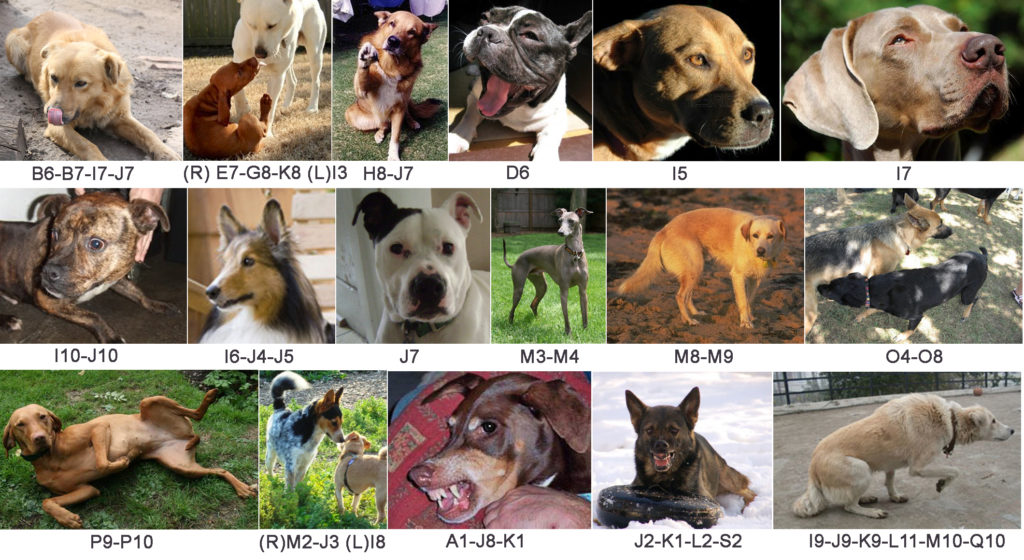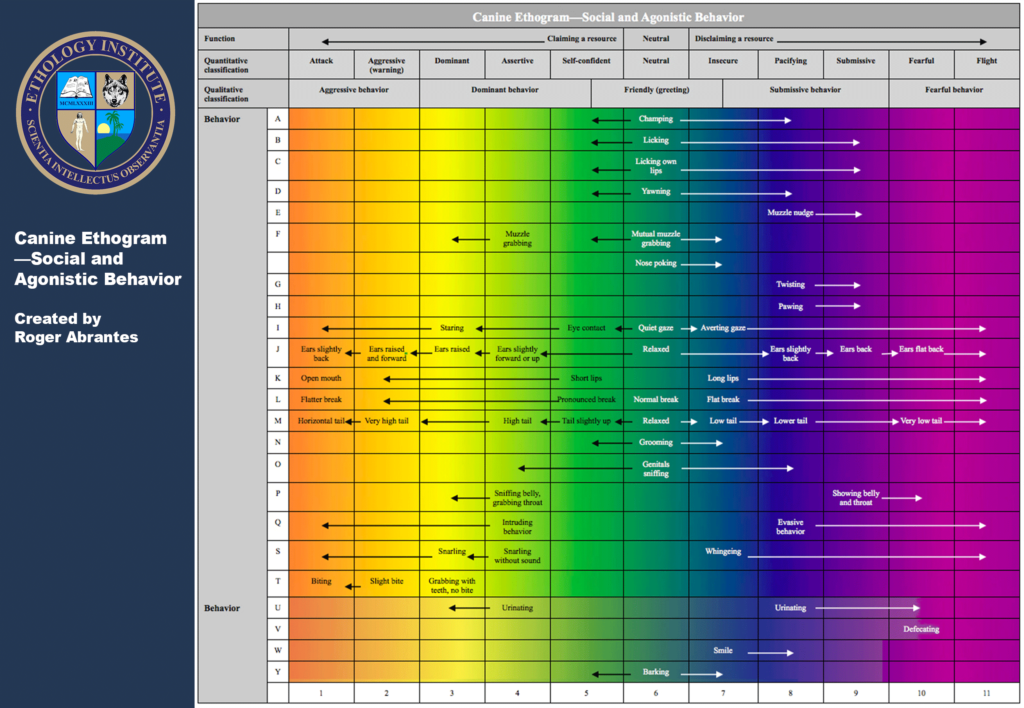Canine Ethogram—Social and Agonistic Behavior is a catalog of a class of canine behaviors. It includes the most commonly observed behaviors but it’s not an exhaustive list.
Behavior is the response of the system or organism to various stimuli, whether internal or external, conscious or subconscious, overt or covert, and voluntary or involuntary.
Behavior does not originate as a deliberate and well-thought strategy to control a stimulus. Initially, all behavior is probably just a reflex, a response following a particular anatomical or physiological reaction. Like all phenotypes, it happens by chance and evolves thereafter.
Natural selection favors behaviors that prolong the life of an animal and increase its chance of reproducing; over time, a particularly advantageous behavior spreads throughout the population. The disposition (genotype) to display a behavior is innate (otherwise the phenotype would not be subject to natural selection and evolution), It requires, though, maturation and/or reinforcement for the organism to be able to apply it successfully. Behavior is, thus, the product of a combination of innate dispositions and environmental factors. Some behaviors require little conditioning from the environment for the animal to display it while other behaviors require more.

Pictures illustrating canine social and agonistic behavior. For the classification of the behavior, please see ethogram below. Behavior is dynamic (not static). All interpretations are therefore only approximate and as pictures allow.
An organism can forget a behavior if it does not have the opportunity to display it for a period, or the behavior can be extinguished if it is not subject to reinforcement for a period.
Evolution favors a systematic bias, which moves behavior away from a maximization of utility and towards a maximization of fitness.
Social behavior is behavior involving more than one individual with the primary function of establishing, maintaining, or changing a relationship between individuals, or in a group (society).
Most researchers define social behavior as the behavior shown by members of the same species in a given interaction. That excludes behavior such as predation, which involves members of different species. On the other hand, it seems to allow for the inclusion of everything else such as communication behavior, parental behavior, sexual behavior, and even agonistic behavior.
Sociologists insist that behavior is an activity devoid of social meaning or social context, in contrast to social behavior, which has both. This definition does not help us much. All above-mentioned behaviors do have a social meaning and a context unless ‘social’ means ‘involving the whole group’ (society) or ‘a particular number of its members.’ In that case, we should ask how many individuals we need in an interaction to classify it as social. Are three enough? If so, then, sexual behavior is not social behavior when practiced by two individuals, but becomes social with three or more being involved, which is not unusual in some species. We can use the same line of arguing for communication behavior, parental behavior, and agonistic behavior. It involves more than one individual, and it affects the group (society), the smallest possible consisting of two individuals.
Agonistic behavior includes all forms of intraspecific behavior related to aggression, fear, threat, fight or flight, or interspecific when competing for resources. It explicitly includes behaviors such as dominant behavior, submissive behavior, flight, pacifying, and conciliation, which are functionally and physiologically interrelated with aggressive behavior, yet fall outside the narrow definition of aggressive behavior. It excludes predatory behavior.
Dominant behavior is a quantitative and quantifiable behavior displayed by an individual with the function of gaining or maintaining temporary access to a particular resource on a particular occasion, versus a particular opponent, without either party incurring injury. If any of the parties incur injury, then the behavior is aggressive and not dominant. Its quantitative characteristics range from slightly self-confident to overtly assertive.
Dominant behavior is situational, individual and resource related. One individual displaying dominant behavior in one specific situation does not necessarily show it on another occasion toward another individual, or toward the same individual in another situation.
Dominant behavior is particularly important for social animals that need to cohabit and cooperate to survive. Therefore, a social strategy evolved with the function of dealing with competition among mates, which caused the least disadvantages.
Aggressive behavior is behavior directed toward the elimination of competition while dominance, or social-aggressiveness, is behavior directed toward the elimination of competition from a mate.
Fearful behavior is behavior directed toward the elimination of an incoming threat.
Submissive behavior, or social-fear, is behavior directed toward the elimination of a social-threat from a mate, i.e. losing temporary access to a resource without incurring injury.
Resources are what an organism perceives as life necessities, e.g. food, mating partner, or a patch of territory. What an animal perceives to be its resources depends on both the species and the individual; it is the result of evolutionary processes and the history of the individual.
Mates are two or more animals that live closely together and depend on one another for survival.
Aliens are two or more animals that do not live close together and do not depend on one another for survival.
A threat is everything that may harm, inflict pain or injury, or decrease an individual’s chance of survival. A social-threat is everything that may cause the temporary loss of a resource and may cause submissive behavior or flight, without the submissive individual incurring injury. Animals show submissive behavior by means of various signals, visual, auditory, olfactory and/or tactile.

Canine ethogram for social and agonistic behavior. The colors illustrate that the categories are constructed by us. When a behavior turns into another one is a matter of convention and interpretation (illustration by Roger Abrantes).
The diagram does not include a complete list of behaviors (please, click on the diagram to enlarge it).
_________________
PS—I apologize if by chance I’ve used one of your pictures without giving you due credit. If this is the case, please e-mail me your name and picture info and I’ll rectify that right away.
Featured Course of the Week
Ethology Ethology studies animal behavior in its natural environment. It is one of the fundamental courses in your curriculum. A reliable knowledge of animal behavior is the basis to create a satisfying relationship with any animal we train.
Featured Price: € 168.00 € 98.00

Learn more in our course Ethology. Ethology studies the behavior of animals in their natural environment. It is fundamental knowledge for the dedicated student of animal behavior as well as for any competent animal trainer. Roger Abrantes wrote the textbook included in the online course as a beautiful flip page book. Learn ethology from a leading ethologist.

2 thoughts on “Canine Ethogram—Social and Agonistic Behavior”
Comments are closed.